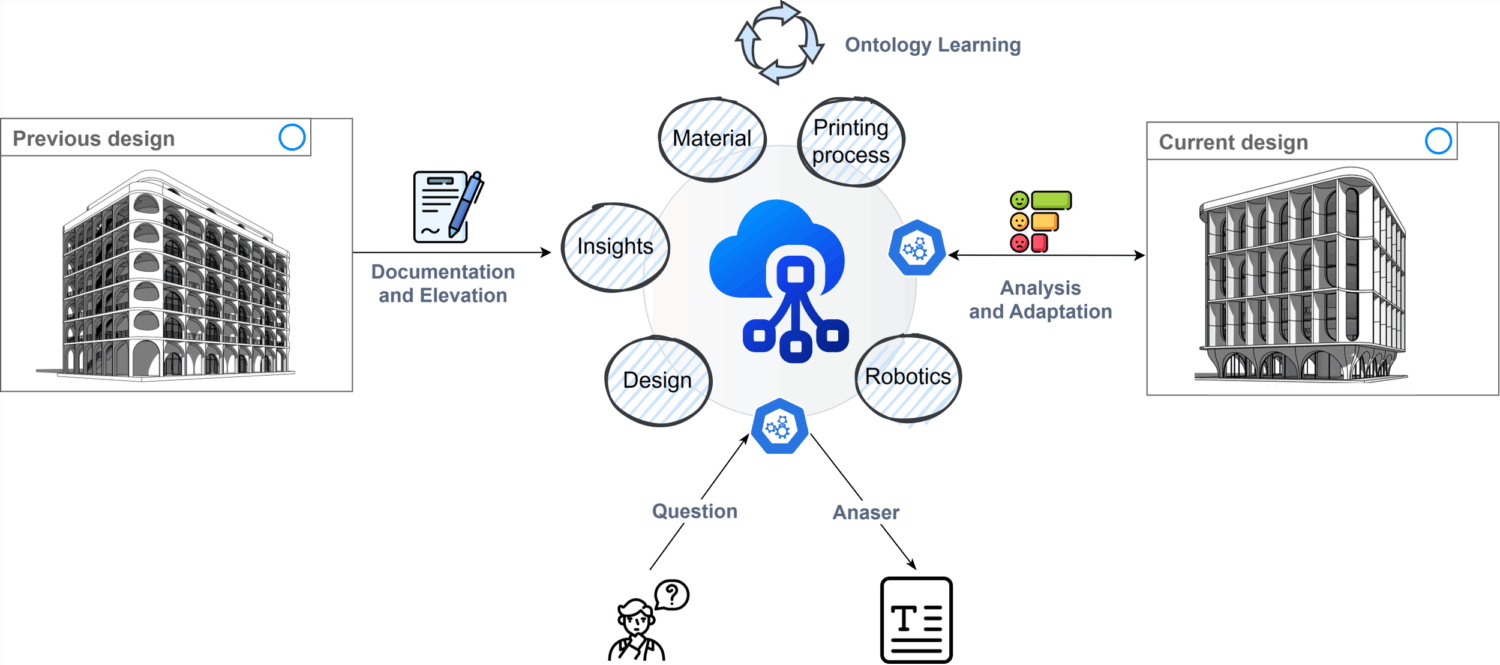Research Summary Report of C04
Particle-Bed 3D Printing by Selective Cement Activation (SCA) – Sustainability, process enhancement and material models
[02.05.2025]
M. Sc. Chao Li Researcher, chao1.li@tum.de
Prof. Dr.-Ing. Frank Petzold Project leader, petzold@tum.de
Technical University of Munich, TUM School of Engineering and Design, Chair of Architectural Informatics
Project C04-WP1 aims to conceive a design decision support system (DDSS) to integrate AM technologies in the early design phase. Project C04 has formalized a ontology-based knowledge base, enabling analysis of AM for building design regarding geometric and functional conformity. The DDSS will be strengthened by implementing the case-based reasoning (CBR) method to integrate AM experts’ know-how, experience, and practical examples into the architectural design process.
Summary
Recent construction projects have demonstrated the feasibility of additive manufacturing (AM) in the construction industry, with expertise accumulated in each of the relevant disciplines. But how to design a building that can be printed? This brings up a range of considerations, including the form and function of building elements, their manufacturability, and the capabilities of AM methods. Answering this question, we aim to develop a full-fledged design decision support system (DDSS), integrating the cross-domain knowledge and essential simulation tools into the design process. A knowledge base is built upon a well-organized ontological framework, consisting of modules for building design, robot systems, AM processes and textural insights from domain experts. Meanwhile, continuous documentation and learning procedures are conducted to guarantee its scalability. To strengthen the interactivity between design and the knowledge base, state-of-the-art large language models (LLMs) will be employed for intuitive question answering. With such, we believe that the DDSS will assist the architects to develop manufacturable design and find optimal AM methods whenever possible. Driven by cross-disciplinary knowledge, DDSS has great potential to link architectural design with AM methods, thereby promoting a wider adoption of additive construction.
Current state of research
In the current phase, we have deepened the proposed framework (see Figure 1) from three perspectives: first, we have improved the ontology-driven documentation tool with detection of space topology, elements connectivity and their individual semantics – they are transformed into a graph which keeps the documented texts at the same place; further, we have leveraged LLM to automate the text-to-graph process such that documented texts can also be transformed into their graph representation, enabling the continuous enrichment of the knowledge graph; to utilize the knowledge graph in decision-making, we are now developing a knowledge graph question answering (KGQA) application with principle of retrieval augmented generation (RAG). To advance the explanation of QA, we exploited subgraph matching algorithms to present relevance in the knowledge graph.
As visualized in Figure 2, we employed the Gemini 2.5 Flash model to generate the knowledge graph with ontology and text as inputs. Specifically, we instruct (prompt engineering) the model to strictly follow the ontology as the data schema – thanks to the ontological commitment of realism, multi-domain knowledge can be mapped into a compressed set of terms. The graph generated is a connected one, i.e., each node is at least connected to another by some paths. This can be attributed, in part, to the initially accurate narratives; more notably, however, it reflects the precise translation from textual descriptions to graphical representations that align closely with the ontologies we proposed.

Figure 1: Deploying LLM-enabled Knowledge Graph Question Answering for Design Decision Support / Credit: Li, AI, TUM

Figure 2: Text describing a Shotcrete expriment has been automatically transformed into knowledge graph using Gemini, visualization done in Neo4j / Credit: Li, AI, TUM
Figure 3: Process / Credit: Li, AI, TUM






